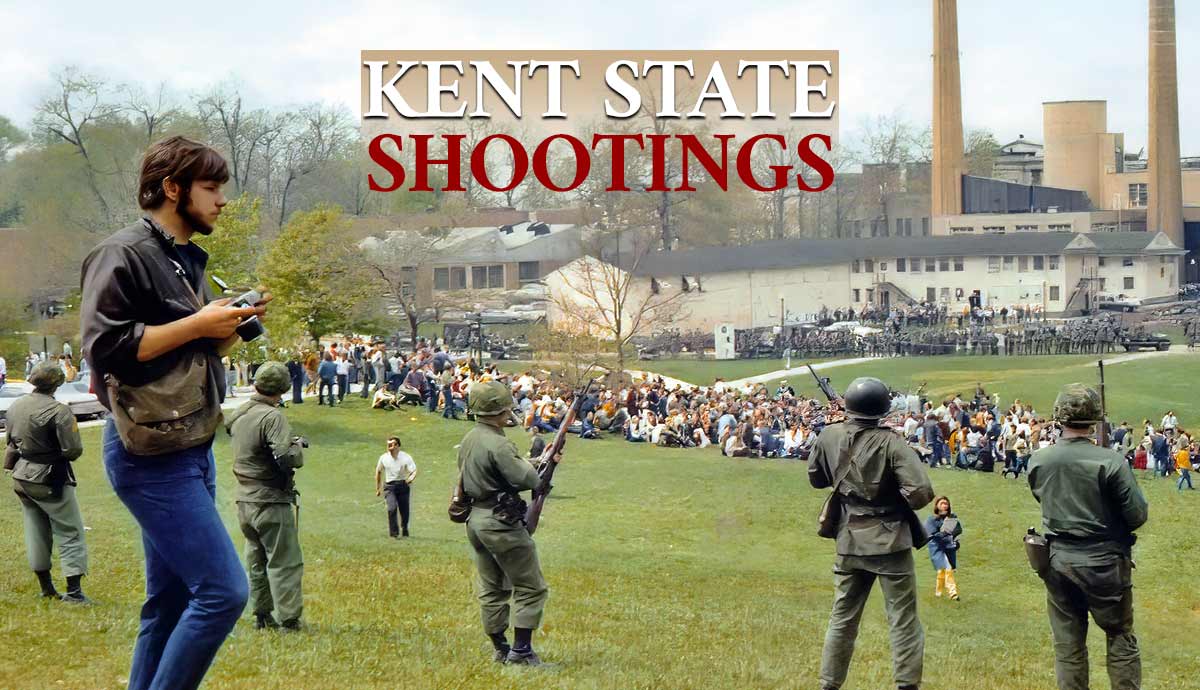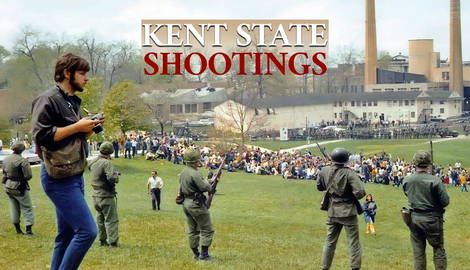
Following the death of President Kennedy, there was a policy change in how the Vietnam War was conducted. Operations were expanded to encompass a more conventional form of war that demanded a larger ground force and an increased zone of operation.
In March 1969, the United States started bombing Cambodia, widening the war to include neighboring countries. In December, the US government introduced the draft. And while American forces fought overseas, a different war was being fought at home.
Protests gripped the nation. The police forces were spread thin, and the National Guard often had to be deployed. It was only a matter of time before a disaster occurred.
At Kent State University, the National Guard opened fire.
Escalation in Vietnam

Between 1963 and 1968, the number of US troops in Vietnam was raised from 16,000 to 500,000. Despite the massive increase in troop numbers, very little progress was made in defeating the Vietcong and the Viet Minh.
Those in America who opposed the war were hopeful when Nixon became president in 1968, as he claimed he would end US involvement in Vietnam. Contrary to his promises, he expanded the war, bombing Cambodia and introducing the draft lottery, forcing American civilians into the ranks of the military fighting in Vietnam.
With incidents like the Mỹ Lai Massacre adding fuel to the fire of dissent, people around America took to the streets in protest. In 130 universities across the country, students marched.
Kent State University in Ohio had long been a hub of anti-war sentiment and was one of those universities.
The Unrest Begins

After the announcement of the expansion of the war into Cambodia, the protests spiked. The public protests at Kent State started on May 1 when students symbolically buried a copy of the Constitution. At around midnight that evening, unrest gripped the city of Kent. A group of people leaving a bar started throwing bottles at police cars. Several shop windows were smashed as tensions escalated. The entire Kent police force was called to duty and confronted the crowd, which had a large core of students and bikers.
The unrest continued throughout the night, and on Saturday, May 2, the mayor of Kent, Leroy Satrom, asked Ohio Governor James Rhodes to give the green light for the deployment of National Guard troops to the streets of Kent and the university. The crowd was eventually dispersed with the use of tear gas.
Saturday was a day defined by fear and rumor.
Reports told of merchants that had been threatened with violence unless they displayed anti-war slogans, and wild speculation, believed by some, envisioned that the students had hidden caches of weapons and had built tunnels under the city in order to blow up the main store and spike the water supply with LSD.
At 5:00 pm, the decision was made to deploy the National Guard, and by 10:00 pm, their boots were on the ground at Kent State University. When they arrived, a demonstration was in full swing, and the Reserve Officers’ Training Corps (ROTC) building on the campus had been set on fire.

The following day, Governor Rhodes made a public announcement in which he shared no sympathy for the protestors at all. He regarded the protestors with absolute contempt.
“…They only have one thing in mind and that is to destroy higher education in Ohio. they’re worse than the Brown Shirts and the communist element and also the Night Riders and the Vigilantes, the worst kind of people that we harbor in America.”
By declaring the protestors a “well-trained, militant, revolutionary group,” he showed a deep misunderstanding of the protestors and set the stage for a clash that would result in fatalities. This label was in contrast to the students who arrived in the streets in the morning to help with cleanup efforts after the rioting the night before. Meanwhile, on campus, 1,000 guardsmen had been deployed, and the atmosphere between the students and the soldiers was of a friendly nature.
At 8:00 pm, students held a campus rally, which was dispersed with tear gas. After they were dispersed, another crowd formed in the streets of Kent. This time, the crowd was dispersed with the aid of bayonets. At the same time, an 11:00 pm curfew was put into place.
May 4

Despite efforts by campus authorities to have the event canceled, a scheduled protest on May 4 began to take shape. Roughly 2,000 people gathered on the campus commons. A short speech was made, and the protestors carried signs in what was essentially a peaceful protest.
Under the command of Brigadier General Robert Canterbury, two companies of National Guardsmen assembled to confront the protestors and ordered them to disperse. A bullhorn was used, but was too faint for the chanting crowd to hear. As a jeep drove nearer to the crowd, the protesters threw a few rocks, one of which struck the jeep and another which struck a guardsman, although without causing injury.
Teargas was then used, but the wind made this effort ineffective, and several canisters were lobbed back at the soldiers while the crowd began chanting “pigs off campus!” The National Guard responded by advancing with bayonets fixed and guns loaded. An order was given to fire only into the air, but it is unknown whether this order was received clearly by all the guardsmen present.

As the soldiers advanced, the protesters threw stones. It has been suggested that several protesters deliberately brought stones with them to the protest in anticipation of a violent confrontation. The crowd moved back over a steep hill known as Blanket Hill and onto a parking lot on the other side. The soldiers followed and found themselves on a football training field surrounded on all sides by a fence. In a difficult location, they huddled together and survived the storm of rocks being thrown at them for about ten minutes as they made their way back to the top of the hill.
When they reached the top of the hill, many of the soldiers, for reasons unknown, turned round, kneeled, raised their rifles, and opened fire. Most of them shot into the air or the ground, but a few shot straight into the crowd, killing and injuring protesters. Some of the protesters ran, while others assumed that they were being shot at with blanks. It was only after they saw their fellow students on the ground that they realized the enormity of the situation.

Jeffrey Glenn Miller, Allison B. Krause, William Knox Schroeder, and Sandra Lee Scheuer.
Sandra was not even part of the demonstration and was walking to class when she was shot in the neck.
Nine others were injured.

The protesters dispersed, running for cover, while others dragged their wounded comrades to safety. Even after the crowd was dispersing, the guardsmen continued to fire at the backs of their fleeing targets.
After the shooting stopped, the students, now dispersed around the campus, reformed in groups. They were in shock and were trying to speak to each other in an attempt to find out why the guards had opened fire. Several groups of students reported that they were approached by police and told to leave or they would be shot at again.

Some students even planned to attack the guards, but after pleading with them, Professor Glenn Frank managed to get the students to vacate the area. For the next two decades, Glenn Frank devoted his life to researching the incident and wrote a book entitled Anatomy of a Tragedy.
Kent State Shootings: Aftermath

In total, 28 guardsmen had opened fire, and 67 rounds were spent over a period of around 13 seconds, although this latter statistic has been subject to varying reports and could have been as much as half a minute or more.
Testimonies from guardsmen involved were contrary and full of inconsistencies. Some soldiers claimed that they thought they had been given an order to open fire. Some claimed they felt their lives were in danger despite the protesters being over 300 feet away. Eleven soldiers claimed that they were under attack from sniper fire. Still others claimed that the sky was filled with rocks being thrown by students.
Investigations concluded that most of these claims were fabricated. Nevertheless, the cases brought against the National Guard yielded little results. Federal criminal and civil trials turned out in favor of the guardsmen.

In the legal action that followed, both guardsmen and student protesters were put on trial. One non-student protester was convicted of arson for burning the ROTC building, while another two pleaded guilty. Five guards were indicted on felony charges, but there were no convictions.
A financial settlement provided for a total of $675,000 to be paid out to the victims’ families. It was not paid by the guardsmen of the National Guard but by the State of Ohio.
In the days and months that followed, sentiment against the Vietnam War increased even further. What happened at Kent State added fuel to the fire of this movement, and 450 state campuses had to be shut down because of protests. Kent State was closed for six weeks following the shooting.
Five days after the shootings, 100,000 people marched in Washington DC. Nixon’s response to this and the shootings was perceived as being indifferent.
There was a huge public outcry over the incident, which, in part, took the forms of documentaries, music, building of memorials, books, including graphic novels, and plays, amongst many other forms. Perhaps the most famous song to refer to the incident was “Ohio,” performed by Crosby, Stills, Nash & Young.

From a historical perspective, the Kent State Massacre was not an isolated event. It was a symptom of a deeply divided nation and was born out of a desire to resist what was happening in America and Vietnam, as well as Cambodia. The result of the shooting generated an even bigger backlash against the government, and for many protesters, it vindicated their belief that their endeavor was one of justice.
Today, their beliefs are clearly echoed by a population strongly opposed to violent interventionism and brutal police action.










